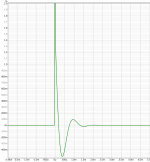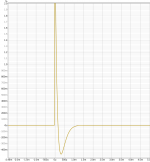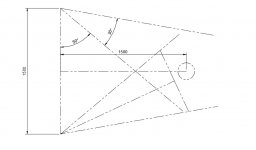BTW, these polar graphs when looking at the horn from the front are great idea - very intuitive! I never got used to these diagrams looking from above but this is just great for a non-axisymmetric device. Is it for a projected spherical surface or a plane in front of the horn? A polar map would show all frequencies in one picture and may be usefull for other things but the actual shape of the pattern is a lot more apparent from these diagrams.
Last edited:
- Thats hard to argue against.Some of Toole's reasoning for more constant directivity is based on the idea that the reflections returning to the listening position will be more similar in timbre to the direct sound which is beneficial.
- outside of a hp filter that gradually slides left, type of effect, the offaxis of these traditional horns are better than Constant directivity...that is, where they are still flat...they are flatter, than Constant directivity.The downsides to a source that doesn't have as constant directivity could be offset in this way through more room treatment like studios used to do and maybe still do when their monitors had/have terrible off axis response, just absorb it all
- It may, is this what I should have experienced with Altec horns? Cause I can't say I recall noticing, so many variables though, really need a side by side comparison.... would you say the 2386 and 2380 are a fair rep for each camp?A source that beams may well have less room interaction at those frequencies but that will introduce an EQ to the sound of the reflections and degrade the overall perception of the speaker.
Well thats from a very large horn.No one is crying about an 80cm coverage that is not huge but workable for a single listener.
plz fill in the blanks, Small.....I was told a large horn will beam too much...the large horn we are looking at is 80cm at 14khz and "workable for a single listener." I'm getting confused. How small is small in cm/inThis will make the sweetspot for all frequencies the horn produces very small.
Which research, cause I can't trust the opinion of the masses, they also desire a smiley face voicing.That can lead to other issues so lots of research is pointing towards less room treatment and smoother off axis response.
Last edited:
BTW, these polar graphs when looking at the horn from the front are great idea - very intuitive! I never got used to these diagrams looking from above but this is just great for a non-axisymmetric device. Is it for a projected spherical surface or a plane in front of the horn? A polar map would show all frequencies in one picture and may be usefull for other things but the actual shape of the pattern is a lot more apparent from these diagrams.
I just updated the post, the polars that are viewing into the horn, those are the jbl2386 polars.
Agree with Art, lbstyling and Earl. camplo, have we not been through this before?
Maybe I missed it but are you going to use digital XO and time align the drivers?
Yes and yes. lol I didn't even do anything! You guys started Arguing about horns, I'm just an innocent bystander lol! The majority of people arguing horn ethics here, have way more experience than me, I can't say that either side is winning...
Jacek Zagaja seems to have a wealth of real world experience with a lot of these horns....hes not team constant directivity or beaming....rather talks about which does what well...according to him, beaming horns are perceived as the most neutral...Ro808 noted that these traditional horns have the most neutral playback, that in no way lines up with the idea that constant directivity has an edge in neutral presentation...Why haven't they taken note to this supposed coloration expectations invited by reflections?
Will it rip a hole in the space time continuum lol, its just a mater of KA.
You made my day!!
No it won't, the same as won't an 8" full range driver, for example. It may not be very enjoyable to listen but won't damage anything.Will it rip a hole in the space time continuum lol, its just a mater of KA.
Is it for a projected spherical surface or a plane in front of the horn? A polar map would show all frequencies in one picture and may be usefull for other things but the actual shape of the pattern is a lot more apparent from these diagrams.
Agreed, much preferred for planning the room, horn pattern requirements.
The whole article [attached].
GM
Attachments
26:51 - YouTube
At YouTube Mr Toole says that if one eq a resonance peak in a loudspeaker, the resonance is gone. Is this really true?
If the speaker indeed "ring" (resonate) at a certain frequency and with a certain Q, lowering the input level for the particular frequency just makes the ringing level be equal to the non-ringing level. I would argue that there is still a ringing there with different Q properties and phase properties than the surrounding non-ringing frequency spectrum. Isn't so that where there is a high Q sharp peak in the FR (and seen in the impedance trace as well!!), the speaker is not minimum phase any longer in that region?
//
Last edited:
It is true. The ringing will be gone - it must be if the device is minimum phase (which is almost a rule for a transducer). The ringing is the bump you see on a frequency response plot. This is one and the same thing. You won't see any associated ringing anymore in the impulse response if you EQ the FR with a minimum phase filter (!) - just any "ordinary" IIR filter will do.At YouTube Mr Toole says that if one eq a resonance peak in a loudspeaker, the resonance is gone. Is this really true?
Last edited:
Yeah, it would ring at 1 kHz. This is how it works.
OK, and if you make that bump Q=0,5?
Still ringing?
//
No, that wouldn't be called ringing as far as I know (it's called critically damped), but the principle is still exactly the same - you always correct for both, the frequency domain and the time domain, in minimum phase systems. Correct one and you can be sure you have corrected the other one as well.OK, and if you make that bump Q=0,5?
Still ringing?
//
That's why the resonances in transducers, if not extremely uncivilized, are not so huge problem - they can be corrected/equalized altogether in electronics (including crossovers, where it is done very often). A break-up of a diaphragm is a problem.
Last edited:
You could call it oscillation if it makes you happier"Ringing" btw is not really a scientific term, is it?
- Home
- Loudspeakers
- Multi-Way
- Is it possible to cover the whole spectrum, high SPL, low distortion with a 2-way?


